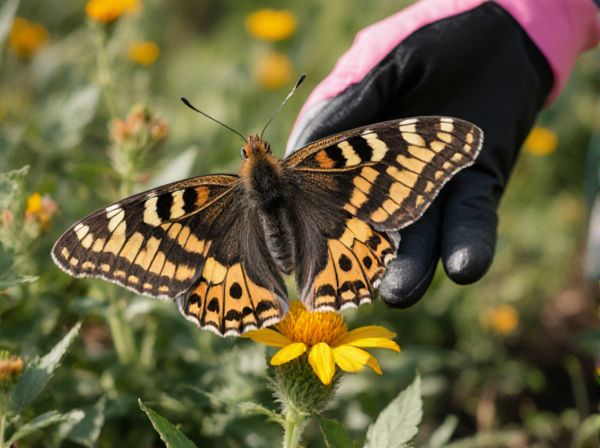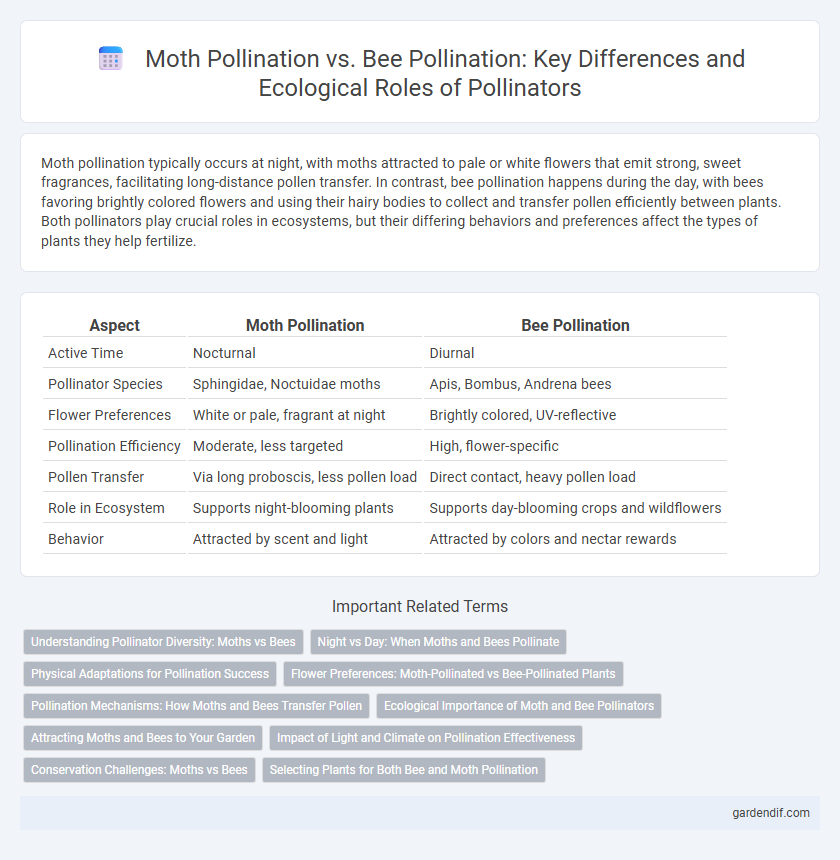
Moth Pollination vs Bee Pollination Illustration
Moth pollination typically occurs at night, with moths attracted to pale or white flowers that emit strong, sweet fragrances, facilitating long-distance pollen transfer. In contrast, bee pollination happens during the day, with bees favoring brightly colored flowers and using their hairy bodies to collect and transfer pollen efficiently between plants. Both pollinators play crucial roles in ecosystems, but their differing behaviors and preferences affect the types of plants they help fertilize.
Table of Comparison
| Aspect | Moth Pollination | Bee Pollination |
|---|---|---|
| Active Time | Nocturnal | Diurnal |
| Pollinator Species | Sphingidae, Noctuidae moths | Apis, Bombus, Andrena bees |
| Flower Preferences | White or pale, fragrant at night | Brightly colored, UV-reflective |
| Pollination Efficiency | Moderate, less targeted | High, flower-specific |
| Pollen Transfer | Via long proboscis, less pollen load | Direct contact, heavy pollen load |
| Role in Ecosystem | Supports night-blooming plants | Supports day-blooming crops and wildflowers |
| Behavior | Attracted by scent and light | Attracted by colors and nectar rewards |
Understanding Pollinator Diversity: Moths vs Bees
Moth pollination primarily occurs at night, enabling the pollination of nocturnal and crepuscular plants with pale, fragrant flowers adapted to attract moths using scent and light reflection. In contrast, bee pollination dominates during daylight hours, with bees favoring brightly colored flowers rich in nectar and pollen, contributing to more targeted and efficient pollen transfer due to their specialized body hairs and flower-handling behaviors. Understanding pollinator diversity highlights the complementary roles of moths and bees in ecosystem stability and agricultural productivity by supporting a wider range of plant species through varied temporal and behavioral pollination strategies.
Night vs Day: When Moths and Bees Pollinate
Moth pollination predominantly occurs at night, leveraging their nocturnal activity and attraction to pale or fragrant flowers that emit scents in the dark, enhancing pollination efficiency. In contrast, bees pollinate mainly during the day, using their vision to identify brightly colored flowers and their ability to collect nectar and pollen efficiently under sunlight. These temporal differences in activity patterns between moths and bees drive distinct pollination dynamics, influencing plant reproductive success.
Physical Adaptations for Pollination Success
Moths possess elongated proboscises that enable them to reach deep floral nectaries, facilitating pollination of night-blooming flowers with tubular shapes. Bees have branched body hairs and pollen baskets on their hind legs, which efficiently collect and transport pollen between flowers. These physical adaptations enhance pollination success by matching the morphology of specific plants and optimizing pollen transfer.
Flower Preferences: Moth-Pollinated vs Bee-Pollinated Plants
Moth-pollinated plants typically exhibit pale or white flowers with strong nocturnal fragrances that attract moths active at night, while bee-pollinated plants display brightly colored flowers such as blue, yellow, or UV patterns that stand out in daylight and often produce nectar guides to lead bees. Moth-pollinated flowers tend to have long corolla tubes suited for the moths' proboscis, contrasting with the open or shallow flowers preferred by bees for easy access. Floral traits such as scent intensity, color wavelength, and nectar accessibility are critical in differentiating plant species adapted to moth versus bee pollination strategies.
Pollination Mechanisms: How Moths and Bees Transfer Pollen
Moths transfer pollen primarily through their hairy bodies as they feed on nectar during nocturnal flights, brushing against flower reproductive organs in deep or tubular blooms adapted for night pollination. Bees collect pollen actively using specialized structures like scopae and corbiculae, which they transport to their nests while simultaneously transferring pollen between flowers through body contact and grooming behaviors. These distinct mechanisms reflect adaptations to their activity periods and floral preferences, maximizing pollination efficiency for diverse plant species.
Ecological Importance of Moth and Bee Pollinators
Moth pollinators contribute significantly to nocturnal pollination networks, supporting the reproduction of night-blooming plants and maintaining biodiversity in various ecosystems. Bee pollinators are crucial for daytime pollination, enhancing crop yields and sustaining global food security through the pollination of numerous agricultural plants. Both moths and bees serve complementary ecological roles, ensuring continuous pollination services across diurnal and nocturnal periods.
Attracting Moths and Bees to Your Garden
Attracting moths to your garden involves planting night-blooming flowers such as evening primrose, jasmine, and nicotiana, which emit strong scents in the dark to lure these nocturnal pollinators. Bees are drawn to brightly colored, fragrant flowers like lavender, sunflowers, and clover, which provide abundant nectar and pollen during daylight hours. Creating habitats with diverse plant species and reducing pesticide use enhances the presence of both moths and bees, supporting effective pollination and a healthy ecosystem.
Impact of Light and Climate on Pollination Effectiveness
Moth pollination thrives in low-light or nocturnal environments, with temperature and humidity significantly influencing moth activity and pollination success. Bee pollination predominantly occurs in daylight, with bees relying on visual cues influenced by light intensity and spectrums to locate flowers. Climate factors such as temperature fluctuations and weather patterns affect the foraging behavior and pollination efficiency of both moths and bees, but moths exhibit greater adaptability to cooler, dim conditions compared to bees.
Conservation Challenges: Moths vs Bees
Moth pollination faces conservation challenges due to habitat fragmentation and light pollution, which disrupt their nocturnal activities and reduce floral resources. Bee populations struggle with pesticide exposure, disease, and loss of nesting habitats, causing significant declines in pollinator diversity and abundance. Effective conservation efforts must address the specific ecological needs of both moths and bees to sustain their crucial pollination services.
Selecting Plants for Both Bee and Moth Pollination
Selecting plants that support both bee and moth pollination enhances garden biodiversity and ensures a wider range of pollinators. Choose species with varying bloom times, such as night-blooming jasmine for moths and sun-loving coneflowers for bees, to attract pollinators active at different periods. Incorporating diverse floral shapes and scents caters to the feeding behaviors of both nocturnal moths and diurnal bees, promoting effective cross-pollination.
Moth Pollination vs Bee Pollination Infographic

 gardendif.com
gardendif.com